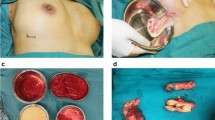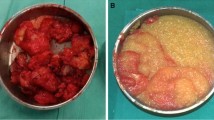Abstract
Background
Polyacrylamide hydrogel (PAAG) was once used as an important injection for breast augmentation though it has been banned in China for more than 10 years. Secondary breast deformity after removing PAAG poses a challenging problem. The aim of this article is to introduce types of breast deformity induced by two types of PAAG based on MRI examination and corresponding treatment strategies.
Methods
From 2008 to 2017, 300 patients with the history of injectable PAAG were reviewed. From their medical history, two types of PAAG injections were imported Interfall and domestic Amazingel, 182 patients received Interfall injection and 118 patients received Amazingel injection. MRI was used as a regular examination preoperatively. According to MRI examinations, breast deformities were classified into nodular type, flow type and mixed type.
Results
All of them underwent PAAG removal operations. In the 182 patients with Interfall injection: There were only 5 cases of nodular type, 3 cases received immediate breast augmentation and 2 cases received second-stage breast augmentation, and none of cases received breast augmentation; there were 170 cases of flow type, 165 cases received immediate breast augmentation and 5 cases received second-stage breast augmentation, and none of cases received breast augmentation; there were 7 cases of mixed type, 5 cases received immediate breast augmentation, 1 case received second-stage breast augmentation and 1 case did not receive breast augmentation; in the 118 patients with Amazingel injection: There were 111 cases of nodular type, 20 cases received immediate breast augmentation, 51 cases received second-stage breast augmentation and 40 cases did not receive breast augmentation; there were 4 cases of flow type, 2 cases received immediate breast augmentation, 1 case received second-stage breast augmentation and 1 case did not receive breast augmentation; there were 2 cases of mixed type, 1 case received second-stage breast augmentation and 1 case did not receive breast augmentation, and none of cases received immediate breast augmentation .
Conclusions
Breast deformity induced by two types of PAAG can be classified into three types based on MRI examinations, which is very critical for preoperative evaluation and classification. Each type of deformity has its own characteristics, which serves as a guide for whether a first-stage or a second-stage prosthesis implant can be implemented. The proportion of patients who can have breast augmentation in the first or second phase after injection of Interfall is significantly higher than that of patients who have injections of Amazingel.
Level of Evidence IV
This journal requires that authors assign a level of evidence to each article. For a full description of these Evidence-Based Medicine ratings, please refer to the Table of Contents or the online Instructions to Authors www.springer.com/00266.












Similar content being viewed by others
References
Breiting V, Aasted A, Jørgensen A, Opitz P, Rosetzsky A (2004) A study on patients treated with polyacrylamide hydrogel injection for facial corrections. Aesthet Plast Surg 28:45–53
Du F, Wang X, Wang Z, Huang W (2019) The long-term results of polyacrylamide hydrogel for augmentation mammoplasty. J Plast Reconstr Aesthet Surg 72:2064
Jin R, Luo X, Wang X, Ma J, Liu F, Yang Q, Yang J, Wang X (2018) Complications and treatment strategy after breast augmentation by polyacrylamide hydrogel injection: summary of 10-year clinical experience. Aesthet Plast Surg 42(2):402–409
Chen B, Song H (2016) Management of breast deformity after removal of injectable polyacrylamide hydrogel: retrospective study of 200 cases for 7 years. Aesthet Plast Surg 40(4):482–491
Shen H, Lv Y, Xu JH, Hong XY, Zeng BW, Xiao W, Zheng LJ (2012) Complications after polyacrylamide hydrogel injection for facial soft-tissue augmentation in China: twenty-four cases and their surgical management. Plast Reconstr Surg 130(2):340e–348e
Ono S, Ogawa R, Hyakusoku H (2010) Complications after polyacrylamide hydrogel injection for soft-tissue augmentation. Plast Reconstr Surg 126(4):1349–1357
Lee CJ, Kim SG, Kim L, Choi MS, Lee SI (2004) Unfavorable findings following breast augmentation using injected polyacrylamide hydrogel. Plast Reconstr Surg 114(7):1967–1968 (No abstract available)
Lin J, Qian YL, Yang Q et al (2007) Clinical analysis of complications of polyacrylamide hydrogel injection for augmentation mammoplasty in 118 cases. Zhonghua Zheng Xing Wai Ke Za Zhi 23:101–102 (in Chinese)
Okubo M, Hyakusoku H, Kanno K, Fumiiri M (1992) Complications after injection mammaplasty. Aesthet Plast Surg 16:181–187
Christensen LH, Breiting VB, Aasted A et al (2003) Long-term effects of polyacrylamide hydrogel on human breast tissue. Plast Reconstr Surg 111:1883–1890
Qiao Q, Wang X, Sun J et al (2005) Management for postoperative complications of breast augmentation by injected polyacrylamide hydrogel. Aesthet Plast Surg 29(3):156–161
Amin SP, Marmur ES, Goldberg DJ (2004) Complications from injectable polyacrylamide gel, a new nonbiodegradable soft tissue filler. Dermatol Surg 30:1507–1509
Wolters M, Lampe H (2009) Prospective multicenter study for evaluation of safety, efficacy, and esthetic results of cross-linked polyacrylamide hydrogel in 81 patients. Dermatol Surg 35:338–343
Sheng-Kang L, Gunang-Ping C, Zhong-Shen S et al (2011) Our strategy in complication management of augmentation mammaplasty with polyacrylamide hydrogel injection in 235 patients. J Plast Reconstr Aesthet Surg 64(6):731–737
Patlazhan G, Unukovych D, Pshenisnov K (2013) Breast reconstruction and treatment algorithm for patients with complications after polyacrylamide gel injections: a 10-year experience. Aesthet Plast Surg 37(2):312–320
Unukovych D, Khrapach V, Wickman MP (2012) Polyacrylamide gel injections for breast augmentation: management of complications in 106 patients, a multicenter study. World J Surg 36(4):695–701
Spear Scott L, Sinkin Jeremy C, Al-Attar Ali (2013) Porcine acellular dermal matrix (strattice) in primary and revision cosmetic breast surgery. Plast Reconstr Surg 131(5):1140–1148
Breuing KH, Warren SM (2005) Immediate bilateral breast reconstruction with implants and inferolateral AlloDerm slings. Ann Plast Surg 55(3):232–239
O’Connell RL, DiMicco R, Khabra K et al (2016) Initial experience of the BREAST-Q breast-conserving therapy module. Breast Cancer Res Treat 160(1):79–89
Liu Liang Q, Branford Olivier A, Mehigan Sinead (2018) BREAST-Q measurement of the patient perspective in oncoplastic breast surgery: a systematic review. Plast Reconstr Surg Glob Open 6(8):e1904
Cohen WA, Mundy LR, Ballard TNS et al (2016) The BREAST-Q in surgical research: a review of the literature 2009–2015. J Plast Reconstr Aesthet Surg 69(2):149–162
Corrêa MPD, Dornelas MT, de Carvalho EN, Barra A, Venturelli EP Jr, Corrêa LD, Chaoubah A (2018) Assessment of quality of life in patients who underwent breast reduction using BREAST-Q. J Plast Reconstr Aesthet Surg 71(6):929–931
Funding
None.
Author information
Authors and Affiliations
Corresponding author
Ethics declarations
Conflict of interest
The authors declare that they have no conflicts of interest to disclose.
Ethical Approval
This study was approved by the IRB.
Informed Consent
Informed consent was acquired from all patients.
Additional information
Publisher's Note
Springer Nature remains neutral with regard to jurisdictional claims in published maps and institutional affiliations.
Rights and permissions
About this article
Cite this article
Zhang, F., Wang, X. & Guo, H. Different Types of Breast Deformity Induced by Two Types of Polyacrylamide Hydrogel and Corresponding Treatment. Aesth Plast Surg 44, 726–734 (2020). https://doi.org/10.1007/s00266-020-01626-0
Received:
Accepted:
Published:
Issue Date:
DOI: https://doi.org/10.1007/s00266-020-01626-0




